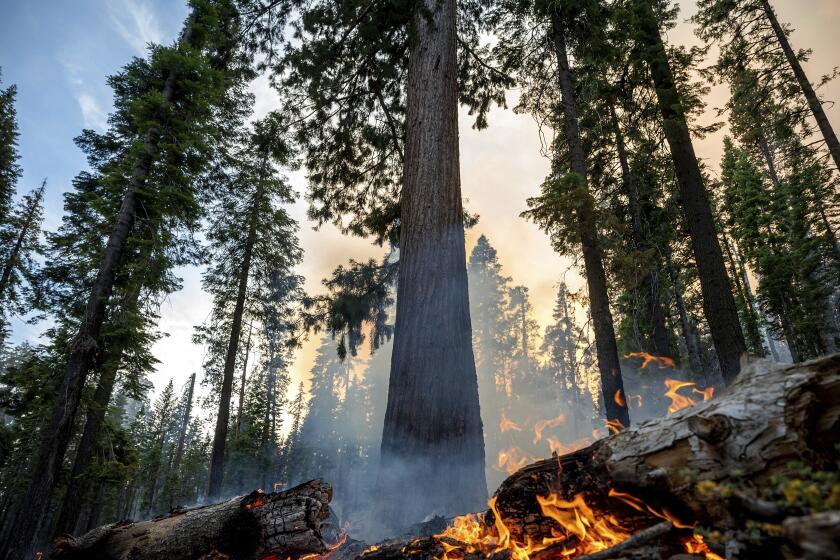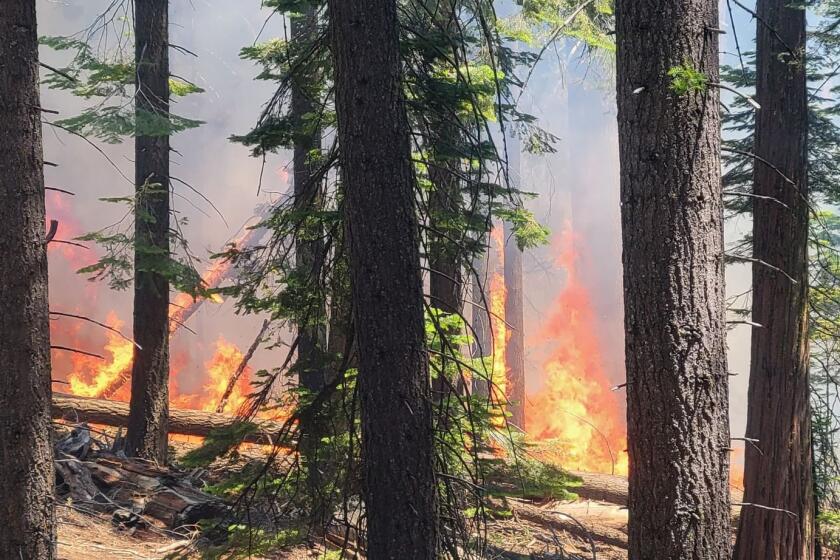Ancient sequoias safe for now as crews continue battling 3,500-acre Washburn fire in Yosemite

- Share via
The Washburn fire in Yosemite National Park continued to grow Tuesday amid hot, dry weather, but officials have become more confident that the Mariposa Grove of ancient sequoias will survive the blaze.
The fire reached 3,516 acres Tuesday night, said Stanley Bercovitz, a U.S. Forest Service spokesperson. A total of 1,045 personnel have been assigned to fight the blaze, which was 17% contained.
“The combination of continued warm and dry weather conditions, along with the heavy accumulation of large fuels, is creating the perfect recipe for the very active fire behavior we are seeing,” officials said in an update Tuesday night. Temperatures were expected to peak Wednesday.
The fire was burning through vegetation on the ground and in the forest understory, “much of which has been largely untouched for many decades,” officials said.
For days, all eyes had been on two high-priority areas threatened by the creeping flames: the community of Wawona, which remains under mandatory evacuation orders, and the Mariposa Grove, home to more than 500 mature sequoias, including the 3,000-year old Grizzly Giant.
There remains some cause for concern, as recent years have seen large numbers of the ancient trees killed by hot, fast fires fueled by climate change. Last year’s KNP Complex and Windy fires in California killed an estimated 3% to 5% of the world’s sequoias, and firefighters at the Washburn fire have set up sprinkler systems to help protect the Grizzly Giant and other at-risk trees.
But sequoias have also evolved with wildfire and in fact rely on extreme heat to help release their seeds. Crystal Kolden, a fire scientist at UC Merced who has been tracking the blaze, said she was “not worried” about the trees in Mariposa Grove.
“They’ve been doing prescribed burns in that grove for over 50 years, and it’s early in the season yet,” Kolden said via email. “This fire should actually be pretty beneficial for them, and it is much better for them to burn in July — which is normally when most of the lightning ignitions are in Yosemite, so it’s the natural fire timing — rather than in September.”
The Mariposa Grove, Wawona, and the Wawona Hotel and campgrounds are closed due to the Washburn fire. Conditions are smoky.
Indeed, many fire experts in recent years have extolled the virtues of “good fire,” which can help clear the century’s worth of dead vegetation that has built up in the state’s forests due to past fire suppression policies. Bercovitz said Yosemite has a good track record of letting fires do their natural work on the landscape, as well as a history of prescribed burns and mastication with heavy machinery.
“The nervousness and the threat level of the Mariposa Grove has dropped way down,” he said Tuesday morning. “Fire did go through the lower portion of the grove, but it was low- and medium-intensity and the kind of fire you like.”
While it was too soon to officially declare the grove safe, he said there are early indications that most trees will survive. A younger tree, about 200 years old, may have been lost, Bercovitz said, but its fate won’t be clear for some time.
But while the Washburn fire has the potential to be beneficial for the grove if current conditions hold, that doesn’t mean crews can relax. The fire grew by about 1,000 acres between Monday and Tuesday mornings, and high temperatures were expected to remain in the area through week’s end.
Despite the gains in acreage Tuesday, Bercovitz said it was “nothing out of the ordinary” and called the suppression effort successful thus far.
The fire has given several indications of its power, including forming a massive pyrocumulus cloud on Monday signaling intense heat. Officials said the cloud was visible for miles, and areas from Sacramento to the Bay Area reported impacts from the fire’s smoke.
Additionally, the blaze was so intense that at one point a tree branch was “sent into the air from the powerful updraft produced by the fire,” the Forest Service said, and “as it dropped back to earth, it narrowly missed two firefighting aircraft.”
The Washburn fire in Yosemite National Park was threatening some 500 giant sequoias, along with the community of Wawona.
Hand crews are not able to reach some sections of the fire due to safety risks, but much of the rest of the blaze is being successfully suppressed, officials said. Crews are strengthening fire lines, burning vegetation in the fire’s path to “starve” the blaze and cooling hot spots.
Heavy smoke is expected to be visible from a distance for the next few days as fire activity increases each afternoon, when temperatures peak and relative humidity is at its lowest, officials said.
Though the Forest Service has yet to give an official cause of the fire, Yosemite National Park Supt. Cicely Muldoon indicated that it was not naturally caused.
“As you all know, there was no lightning on that day, so it’s a human-start fire and it’s under investigation,” she said during a Monday night community meeting. “That’s all I can really say.”
Bercovitz said he confirmed that there were no strikes recorded on the lightning map when the fire sparked Thursday, and that there was no wind and no power lines in the area. But he cautioned that “human start” doesn’t necessarily mean arson, and that it’s still too soon to declare anything for certain.
“As soon as you start talking like that, it automatically points to a person, and who knows?” he said.
What was clearer was the immense value of the forestland that firefighters were working to protect.
“The Mariposa Grove was set aside in 1864 by Abraham Lincoln. It predated both the creation of Yosemite National Park and the National Park Service itself,” Muldoon said during the meeting. “It’s really the root of the whole national park system — a very important place to us, to the community.”
More to Read
Sign up for Essential California
The most important California stories and recommendations in your inbox every morning.
You may occasionally receive promotional content from the Los Angeles Times.















